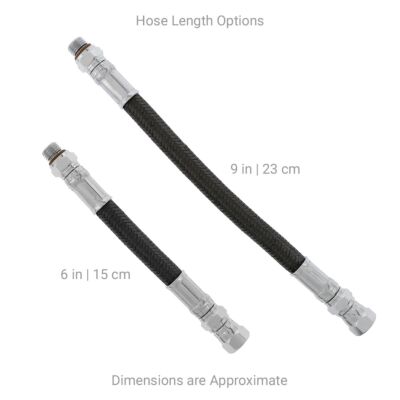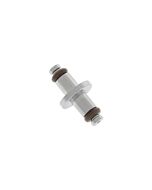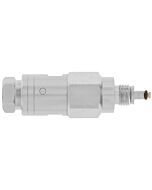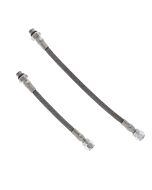High Pressure Hose in SHORT Lengths
- Very short high pressure hoses have special considerations
- Available in your choice of flex, rubber, or stainless steel braid
- Order two or more of the same hose and receive a 10% discount on their price
- Typical OD:12.4+/-0.2mm with 7/16-inch male to 1st stage = 7/16-inch female to SPG or transmitter
- All hoses are Nitrox Ready
High Pressure Hose in SHORT Lengths
- Buy 2 for $19.75 each and save 10%
Because of the special considerations for very short HP hoses, we recommend you always keep a spare in your "save-a-dive" kit. We are offering a 10% discount on their price when two or more of the same very short HP hoses are purchased together.
These short length high-pressure hoses are popular for use with deco, stage and sidemount applications as well as transmitters. Regardless of brand, material or quality the very short high pressure hoses seem to prematurely develop "fizzing" leaks at the fitting swages sooner than the much longer HP hoses typically seen on backmount configurations. We suspect there are two reasons for these premature failures: First, the short hoses are often being folded back on themselves in deco, stage, and sidemount applications. Second, the very short length does not provide any cushion to the impact of rapidly pressurizing the regulator.
See our TekTip below for our recommendations on rigging the SPG with very a short hose, and while the regulator should always be pressurized slowly this is especially critical when the first stage is rigged with a very short HP hose. We recommend following best practice to depress and hold the second stage purge while slowly opening the cylinder valve until the regulator begins equalizing with the cylinder pressure.
Our experience has been the 9-inch length is consistently more reliable than the 6-inch length, regardless of flex or rubber hose construction. Recent availability of the braided stainless steel jacket over an inner nylon tube construction offers improved reliability over the flex and rubber versions. Dive Gear Express now recommends the 9-inch braided stainless steel high-pressure hose for all diving applications that require a short HP hose.
All these high pressure SCUBA hoses have chromed brass fittings, are designed to conform to the EN 250:2014 standard, and are Nitrox Ready. The typical HP hose is 12.4+/-0.2mm outside diameter with a 7/16-inch male at the end that screws into the first stage HP port and a 7/16-inch female swivel at the end that screws on to the SPG or transmitter. All high pressure hoses use an 'air spool' with two tiny o-rings to mate the swivel connector on the hose to the fitting on the gauge. With a worn or missing air spool, any HP hose will LEAK at the swivel. The air spool is not included with the hose but we recommend replacing the air spool when replacing the hose. The standard spool has the flange in the center as pictured but a few SPGs, typically the plastic body ones, may only accept a spool without a shoulder in which case you will have to reuse the air spool from the SPG.
| Brand | DGX |
|---|---|
| SKU | DX-HP-SHORT |
| Weight | 0.350000 |
Customer Reviews
 WARNING
WARNING
Keep in mind that all SCUBA hoses will fail sooner or later either due to age, storage conditions or handling. Scuba hoses, regardless of brand and materials, require some minimal care. Do not allow hoses to receive prolonged exposure to sunlight, as the heat and UV from strong sunlight will significantly shorten the life of the hose. Do not attempt to flush the inside of the hose with any form of solvent or other chemical, new hoses are factory clean and if you have any reason to think they are no longer clean then the hose should be replaced. Prior to every dive trip you should always pressurize and inspect your hoses for mechanical damage, corroded fittings, bulges and leaks. Dive Gear Express suggests replacing all SCUBA hoses every five years or 500 dives, whichever comes first.
YOU MAY ALSO BE INTERESTED IN THE FOLLOWING PRODUCT(S)
Rigging the SPG on Stage and Sidemount Bottles
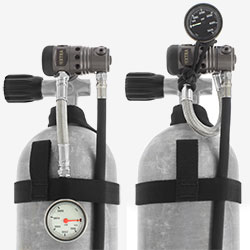
The classic method technical divers use to rig a stage or sidemount bottle is a compact or "brass & glass" gauge assembled with a very short high-pressure hose folded back on itself against the first stage and permanently tied in place with a piece of cave line. We do NOT recommend doing this with a rubber or flex hose because the hose is also permanently stressed at the two weakest points, the fitting swages. Although not as convenient to read, allow the SPG and hose assembly to lie straight against the tank while held against the side of the cylinder under a hose retainer. Because the short hose is less able to absorb the impact of rapid pressurization, we recommend following best practice to depress and hold the second stage purge while slowly opening the cylinder valve until the regulator begins equalizing with the cylinder pressure.
If you prefer folding the hose, then use a bungee loop (about 1 foot of 3/16" with the ends tied together in a fisherman's knot or we prefer an overhand loop w/pigtail) instead of cave line because when the regulator is off the stage the bungee loop allows the hose to be unfolded. Some divers also prefer using a slightly longer hose when folding, hopefully offering a reduction in stress on the folded hose. Regardless, in our experience all short rubber or flex hoses still may fail prematurely from being folded back on themselves. Recent availability of short high-pressure hoses with a braided stainless steel jacket, together with the bungee loop rigging method, seems to be the most durable and reliable compromise.
Here is one final thought... ask yourself "Do I really need a full size SPG?" Sometimes the exact amount of the gas remaining in an off-board bottle is not being used to control the dive. The only reason for the presence of the SPG on the travel or bailout bottle is the diver just needs an indication of cylinder contents as full, partial, or empty. If your diving application doesn't need an exact reading on gas remaining in the cylinder, an inexpensive button SPG will significantly reduce the number of failure points. This is especially true of bailout bottle applications, whereupon switch to bailout also terminates the dive and knowing the exact tank pressure is unlikely to be meaningful.
